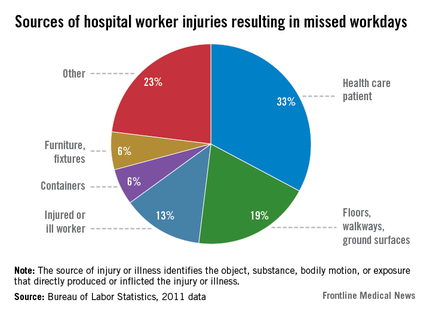Improving hospital worker safety will result in improved patient safety, according to the Occupational Safety and Health Administration, which has unveiled a hospital worker safety online resource center.
Worker Safety in Hospitals: Caring for our Caregivers, OSHA's new website aimed at curbing hospital worker injury rates, was introduced during a media teleconference Jan. 16. According to OSHA, injuries occur at a rate of 158 times per 10,000 workers, making hospitals more hazardous work environments than either construction or manufacturing sites.
National workers’ compensation losses from hospital workers total $2 billion annually, said OSHA assistant secretary Dr. David Michaels.
Musculoskeletal injuries, primarily from lifting and shifting patients, are the single biggest worker injury in hospitals, he said. According to OSHA, 16,680 hospital workers missed work because of a musculoskeletal injury sustained while handling a patient.
"Other hazards facing hospital workers include workplace violence, slips and falls, exposure to chemicals including hazardous drugs, exposure to infectious diseases, and needle sticks," said Dr. Michaels.
As part of a joint effort to promote the website, also on the conference call were Dr. John Howard, director of the National Institute for Occupational Safety and Health, and Dr. Erin DuPree, chief medical officer and vice president of the Joint Commission Center for Transforming Healthcare, and Dr. Lucian Leape, chairman of the Lucian Leape Institute at the National Patient Safety Foundation.
The OSHA website offers educational materials on avoiding injury when handling patients, as well as on workplace safety needs and the implementation of safety and health management systems.
The materials were culled from best practices employed at hospitals around the country deemed by OSHA to be "high-reliability organizations," and include tips such as having a daily "safety huddle" that includes a discussion of "great catches" and "near misses" that occurred during daily operations.
"One of the major barriers in making progress in patient safety is that when people report that they’ve made a mistake, they often get punished for it," said Dr. Leape. "What we’ve been trying to get people to understand is that mistakes happen because of bad systems, not bad people. You have to create an environment where you really believe that, and make it safe for people to talk about their errors so you can understand what you need to fix."
Dr. DuPree said the OSHA resources align with Joint Commission requirements such as those for hospitals to have a written plan for managing environmental safety for patients and all persons in hospitals. The Joint Commission expects that all individuals who work in the hospital should not fear retribution for speaking up about their safety concerns, Dr. DuPree said. "Leaders need to value and empower their workers. They need to understand that fear of reprisal and failure to share knowledge can compromise an organization’s ability to improve safety for all," he said.
As part of its efforts to advise hospital administrators on how to create safer work environments for their employees, the U.S. Department of Labor Occupational Safety and Health Administration has created a list of attributes of what it calls "high-reliability organizations."
Self-assessment tools, tip sheets, and other materials intended to help hospitals become high-reliability organizations (HROs) are available at OSHA's new website, Worker Safety in Hospitals: Caring for our Caregivers.
"The heart of these new materials are real life lessons from high-performing hospitals [that] have implemented best practices to reduce workplace injuries while also improving patient safety," said OSHA assistant secretary Dr. David Michaels in a press briefing.
The website emphasizes principles endorsed by the Joint Commission, particularly the promotion of a "no-blame" culture to destigmatize safety interventions. Operational strategies derived from the distillation of these best practices and endorsed by OSHA include the following:
• Sensitivity to operations. That means hospital workers should know what the standard procedures are, and follow them.
• Reluctance to simplify. This tenet calls upon hospital administrators to explore the larger context in which safety failures occur.
• Preoccupation with failure. OSHA warns administrators to "never let success breed complacency" and impels hospital leaders to "focus unceasingly on ways the system can fail" and to encourage staff to "listen to their ‘inner voice’ of concern."
• Deference to expertise. Pulling rank rather than going to the one who has the most direct experience in a situation is discouraged by OSHA.
• Resilience. Basically, know there will be failures, but hopefully only small ones; learn from them and rebound.
Dr. Michaels, Dr. Howard, Dr. DuPree, and Dr. Leape did not report any relevant financial disclosures.


